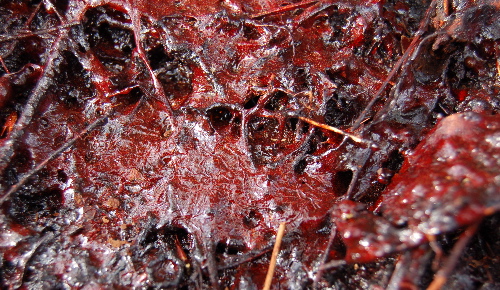[In a new development, all of the photos in this blog entry can be viewed in a larger size if you click on them.]
In the above photo you can see the skin of a Wandoo. While the leaves fell each autumn back in Europe, when white people came to this land they found an invertion of their experience: here it was the bark that was shed as the seasons turned. Some Australian trees have a thick layer of bark to insulate them from the fierce fires which can burn in summer. Others, like this Wandoo, sacrifice their bark to the flames to escape too much damage to their trunks. To be honest this tree is normally found a bit further inland and had been planted by human hands.
After the previous blog I wrote on soil, I thought I’d show that there really is a diversity of natural beauty which springs forth from my sandy home.
Between the Indian Ocean and the hills behind Perth, the Darling Scarp, sits the Swan Coastal Plain. This is an area of Banksia and Eucalypt Woodland. Agriculture and urbanisation have lead to clearing and fragmentation of this woodland, however pockets remain. Murdoch University has one of the largest campuses in Australia, and here, camera in hand, I found one of these pockets of original life.
Now we’re in the real woodland. There are plenty of species of Banksias endemic around here (50-60), and this is the immature flower of one of them (I think it is Banksia ilicifolia). Its conical shape makes me think of it, for some reason, as a trophy of the bush. Aboriginal Australians used to soak Banksia flowers in water and then drink the water for a sweet beverage. Each Banksia cone is actually covered with thousands of tiny little flowers and each flower is dripping in nectar, a high-sucrose substance. Each year the Banksia grandis, the most imposing looking Banksia flower, would bloom and the Australians would gather to celebrate the ‘yellow season’. Sounds good to me.

This is the sap of a Marri tree. Marri trees are always giving you the impression that they are bleeding from a mortal wound, and layering their dried blood on the woodland floor beneath them. In fact this stuff is properly called kino, and is a sugary exudation from the Marri which was used by the first Australians as a medicine.
Nuytsia floribunda, or the Christmas Tree, puts out some new flowers, soon to be a riot of yellow and orange (those are a couple of Marri trees in the background). I really love these trees. Every December I know it is getting close to Christmas when these beautiful flowers start to explode out of the dull green leaves of certain trees. Forget the bunting in the main street of the city, this is the real colour of our yearly celebration. Of course it is pure chance that this tree works in time with a ritual derived from a land over thirteen thousand kilometres away.


